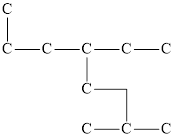
Concept explainers
Interpretation:
The name of the compound whose carbon skeleton is given is to be determined.

Concept introduction:
The IUPAC naming of compounds is a systematic way to name the organic compounds.
Steps to determine the IUPAC name of a compound are as follows:
Step 1: Identify the longest carbon chain and number them such that the substituents are attached to the main chain on the lowest number.
Step 2: Then identify the carbon number to which the substituents are attached.
Step 3: Identify the substituent attached to the carbon in the carbon chain.
Step 4: While naming the compounds two digits are separated by a comma (,) and the digit is separated from a letter by a hyphen (-).If more than one substituent is present, then they are named in the order of alphabetical order. If the similar substituents are present in many, then the number of substituents is indicated by prefixes di, tri, tetra, etc.
Trending nowThis is a popular solution!

Chapter 21 Solutions
Introductory Chemistry: An Active Learning Approach
 Introductory Chemistry: An Active Learning Approa...ChemistryISBN:9781305079250Author:Mark S. Cracolice, Ed PetersPublisher:Cengage Learning
Introductory Chemistry: An Active Learning Approa...ChemistryISBN:9781305079250Author:Mark S. Cracolice, Ed PetersPublisher:Cengage Learning Chemistry: Principles and PracticeChemistryISBN:9780534420123Author:Daniel L. Reger, Scott R. Goode, David W. Ball, Edward MercerPublisher:Cengage Learning
Chemistry: Principles and PracticeChemistryISBN:9780534420123Author:Daniel L. Reger, Scott R. Goode, David W. Ball, Edward MercerPublisher:Cengage Learning Chemistry: Principles and ReactionsChemistryISBN:9781305079373Author:William L. Masterton, Cecile N. HurleyPublisher:Cengage Learning
Chemistry: Principles and ReactionsChemistryISBN:9781305079373Author:William L. Masterton, Cecile N. HurleyPublisher:Cengage Learning- Chemistry: Matter and ChangeChemistryISBN:9780078746376Author:Dinah Zike, Laurel Dingrando, Nicholas Hainen, Cheryl WistromPublisher:Glencoe/McGraw-Hill School Pub Co
 ChemistryChemistryISBN:9781305957404Author:Steven S. Zumdahl, Susan A. Zumdahl, Donald J. DeCostePublisher:Cengage Learning
ChemistryChemistryISBN:9781305957404Author:Steven S. Zumdahl, Susan A. Zumdahl, Donald J. DeCostePublisher:Cengage Learning World of Chemistry, 3rd editionChemistryISBN:9781133109655Author:Steven S. Zumdahl, Susan L. Zumdahl, Donald J. DeCostePublisher:Brooks / Cole / Cengage Learning
World of Chemistry, 3rd editionChemistryISBN:9781133109655Author:Steven S. Zumdahl, Susan L. Zumdahl, Donald J. DeCostePublisher:Brooks / Cole / Cengage Learning





